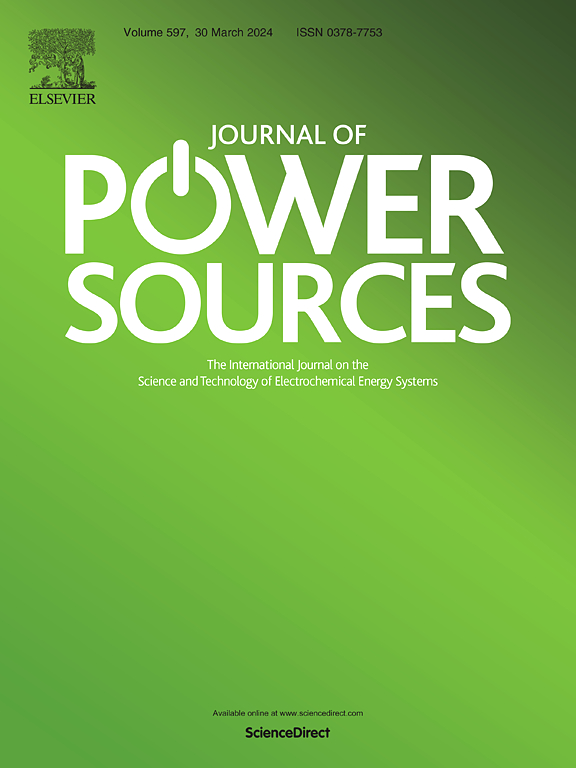阴离子诱导的非水锌-空气电池性能优化:OTF- 选择的启示
IF 8.1
2区 工程技术
Q1 CHEMISTRY, PHYSICAL
引用次数: 0
摘要
可充电非碱性锌-空气电池(ZAB)解决了传统碱性电池不兼容 CO₂ 和不稳定的问题。然而,氧化锌等固体放电产物对空气阴极放电容量的影响仍未得到研究。在本研究中,我们使用三氟甲磺酸锌(Zn(OTF)₂)-N, N-二甲基甲酰胺(DMF)和醋酸锌(Zn(Ac)₂)-DMF 电解质研究了阴离子如何影响离子对溶解结构,以及这些结构如何影响放电产物的分布。我们的研究结果表明,供体数(DN)较低的阴离子(如较弱的配体 OTF- (20.5))可提高锌离子的活性,并在放电过程中促进 Zn2⁺ 与氧气的快速反应,从而使放电容量增加十倍以上。相反,DNs(43.3)较高的醋酸阴离子会形成稳定的络合物,抑制锌离子的活性,并导致形成膜状放电产物,从而降低 ZAB 的性能。Zn(OTF)₂-DMF 电解质还能使电池寿命超过 200 小时,是醋酸盐体系的五倍以上。本文章由计算机程序翻译,如有差异,请以英文原文为准。

Anion-induced optimization of non-aqueous zinc-air battery performance: Insights into OTF− selection
Rechargeable non-alkaline zinc-air batteries (ZABs) address the CO₂ incompatibility and instability issues of conventional alkaline batteries. However, the impact of solid discharge products like zinc oxide on discharge capacity at the air cathode remains unexplored. In this study, we investigate how anions influence ion pair solvation structures using Zinc trifluoromethanesulfonate (Zn(OTF)₂)-N, N-dimethylformamide (DMF) and Zinc acetate (Zn(Ac)₂)-DMF electrolytes, and how these structures affect the distribution of discharge product. Our finding shows that anions with lower donor numbers (DNs), like the weaker ligand OTF- (20.5), enhance the zinc ion activity and promote rapid Zn2⁺ reactions with oxygen during discharge, leading to a more than tenfold increase in discharge capacity. In contrast, acetate anions with higher DNs (43.3) form stable complexes, inhibiting zinc ion activity and causing the formation of film-like discharge products, which reduces ZAB performance. The Zn(OTF)₂-DMF electrolyte also enables a battery lifespan of over 200 h, more than fivefold compared to the acetate-based system.
求助全文
通过发布文献求助,成功后即可免费获取论文全文。
去求助
来源期刊

Journal of Power Sources
工程技术-电化学
CiteScore
16.40
自引率
6.50%
发文量
1249
审稿时长
36 days
期刊介绍:
The Journal of Power Sources is a publication catering to researchers and technologists interested in various aspects of the science, technology, and applications of electrochemical power sources. It covers original research and reviews on primary and secondary batteries, fuel cells, supercapacitors, and photo-electrochemical cells.
Topics considered include the research, development and applications of nanomaterials and novel componentry for these devices. Examples of applications of these electrochemical power sources include:
• Portable electronics
• Electric and Hybrid Electric Vehicles
• Uninterruptible Power Supply (UPS) systems
• Storage of renewable energy
• Satellites and deep space probes
• Boats and ships, drones and aircrafts
• Wearable energy storage systems
 求助内容:
求助内容: 应助结果提醒方式:
应助结果提醒方式:


